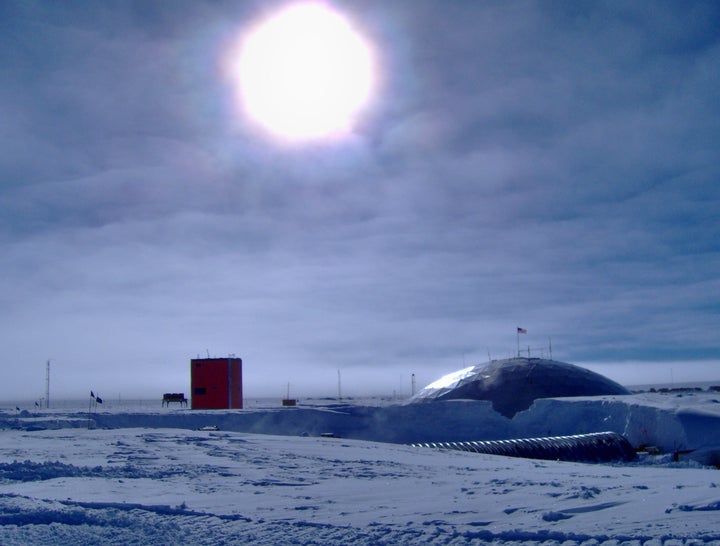
The Amundsen-Scott Station, a scientific research base, sits atop the most desolate patch of snow on earth: the geographic South Pole.
Carbon dioxide freezes to dry ice at -109 degrees Fahrenheit. By South Pole standards, that's just a nippy day. Winter temperatures have dipped to -117 degrees. It's easily the coldest, most lifeless place on Earth -- the "on Earth" part being crucial: While the North Pole's ice cap floats on water, the South Pole's sits on rock. While the north's is thin (15 feet, average), the south's is nearly two miles thick.
Because of such extremes, the station is cut off from the world for eight months - between March and November - winter at the bottom of the earth. When it is below -50 degrees, nobody can fly in or out; metal landing gear on aircraft snaps like twigs, and engine oil turns to jelly.
Ever since I was a child, I had wanted to visit this mysterious place, so I joined a "Ski the Last Degree" expedition. The plan was to fly to 89 degrees south, then battle mother nature the remaining 70 miles to the Pole, cross-country skiing with equipment, food and personal gear in sleds behind us.
After five separate flights -- New York to Lima; Lima to Santiago; Santiago to Punta Arenas; Punta Arenas to Patriot Hills, Antarctica; Patriot Hills to 89 South -- our group of four intrepids set out on the polar plateau, where bone-chilling wind is the norm and even birds can't survive. The landscape is a flat ice desert and, had we not had a GPS, we would have had no idea in which direction to ski.
It was summer (December), but that didn't mean it was easy. Because the plateau is 9,300 feet above sea level the cold air, rarely above zero, is thin and the body acclimates to oxygen deprivation grudgingly. I had a splitting headache and nausea for the first few days. Couple that with the 110-pound sled loads we were pulling -- well, you get the exhausting picture!
Our routine was similar each day. We awoke at 7 a.m., then fired up stoves to melt snow for a breakfast of oatmeal and hot cocoa. By 10 a.m., tents were dismantled and camp packed up. Then the real work began: eight grueling hours of skiing.
Day after day, we pushed on for a solid 60 minutes at a time, then broke for 15 minutes, then skied another 60 minutes, then took a break, and so on. Burning 1,000 calories an hour, we ate as much chocolate, dried fruit and nuts as possible during the breaks, washing them down with hot drinks from thermoses.
When the wind kicked up, we quickly donned face masks, since at those temperatures any exposed skin is frostbitten within minutes. Was it tough? Three days in, I leaned over to our guide and panted, "Of this much I am certain: If there is such a thing as reincarnation, I do not want to come back as a sled dog."
Despite the struggles, I couldn't help but admire the view, otherworldly and beautiful. One day brought with it "sun dogs," a phenomenon whereby a large rainbow rings the sun, with two false suns on either side. Another day, tiny ice crystals began falling from a perfectly clear blue sky.
We stared at the ground, looking, unsuccessfully, for meteorites. The area near the South Pole is perhaps the world's best place to hunt, because a dark rock against a white background is easy to spot. If you spot one in such isolated ice, you can be sure it didn't come from anywhere but the sky.
In the "evening", we would set up camp. Then there was more snow melting to prepare freeze-dried dinners. Afterward, we'd hit our sleeping bags, rated -40 degrees, for some rest. Even this was difficult. In the height of the Antarctic summer the sun just rolls around the edge of the sky like a giant yellow balloon.
After six days, the Amundsen-Scott Station finally appeared, first as a dot on the horizon, later as a small complex of buildings. It took yet another day to reach it, but once there we were treated to a hot meal and tour by the National Science Foundation staff, which controls the base. It houses about 240 people during the summer, but in winter the number drops to just 60 hearty souls. We camped in tents there for three days.
Established in 1957 by the U.S. to mark the International Geophysical Year, the base has character. In the dining room there was an upside-down globe with Antarctica on top. There is a small store for souvenirs and a post office, where we had our passports stamped.
We marveled at a well decorated Christmas tree in the mess hall and visited the CalTech telescope and the National Oceanic and Atmospheric Administration facility. We even learned about "The 300 Club" -- crazies who, when the temperature hits -100 degrees for the first time in a particular year, strip down, climb into a steaming 200-degree sauna, then head outside to run around the ceremonial pole marker naked.
Tired as I was, I felt immense satisfaction at having reached the South Pole. While I had skied only 70 miles--nothing compared the 1,450 miles covered by Robert Scott, the British explorer who in 1911 raced Norwegian Roald Amundsen to the pole, finished second, and died on his return--we were here, finally, and the wonder of it all wasn't lost on me.